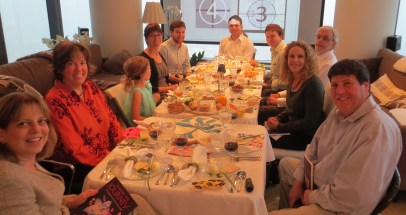Here’s a hint that the intersection of Judaism and sexuality is a complex, multi-faceted, and endlessly fascinating topic: the new CCAR anthology, The Sacred Encounter: Jewish Perspectives on Sexuality is 810 pages, with over fifty contributions from clergy and thought-leaders from the Reform movement and beyond.
Clearly, there is a lot to say – and I’m both encouraged and excited by the depth and breadth of perspectives put forward by the book’s editor, Rabbi Lisa Grushcow, and the many authors included in this book. No one takes the easy way out, as each essayist tackles a wide range of issues head-on, employing new, creative approaches for textual analysis, ritual creation, and contemporary policy debates. From same-sex marriage, to infertility, to creating sacred space in cyberspace, these of-the-moment topics address age-old questions with refreshing honesty and intellectual rigor.
We enrich and sanctify these conversations when we convene them within Jewish communities, and this anthology provides us with an incredible tool to do so.
So – where to start? We have synthesized the incredible material included in this volume into a study guide, providing both topic-based tracks and chapter-by-chapter discussion questions.
The tracks, which include Marriage, Social Justice, Sexual Ethics, and more, are appropriate for a variety of adult and young adult education sessions. Each track includes relevant sub-topics and chapters. You could opt to teach the entire track as a longer, multi-part course, or select a particular sub-topic and its associated chapters in the book for a one-time discussion.
We also created tracks that include topics of particular interest for a WRJ/Sisterhood group, MRJ/Brotherhood group, synagogue teen group, or youth workers to discuss together. Synagogue boards may wish to study together using the tracks that include Reform Movement policy perspectives or improving LGBTQ Inclusion. The tracks also serve as a useful topical index – if you’re looking to recommend one chapter for a couple in pre-marital counseling to read, the Marriage track distills sub-topics from sexual intimacy to ritual and legal innovation.
The second part of the study guide includes discussion questions for every chapter of the book. You might use these questions in an adult education course covering one or more of the track-based topics. You could also employ the questions as a starting point for personal reflection after reading a particular chapter. Many of the questions are geared toward how the ideas in a given chapter could be implemented in your synagogue or local Jewish community.
Finally, The Sacred Encounter is full of beautiful personal reflections related to the broader topics in the anthology. Included in many of the tracks in the study guide, these reflections also provide an accessible entry-point to the book as a whole.
We look forward to hearing how you are teaching and discussing the many perspectives included in The Sacred Encounter. How do you plan to teach on any of these topics? Please let us know which tracks, discussion questions, and chapters spark the most exciting debates for you! This is only the beginning of what we know will be an incredible conversation.
Liz Piper-Goldberg, CCAR Press Rabbinic Intern/HUC-JIR ‘15, wrote the study guide for The Sacred Encounter
The study guide for The Sacred Encounter is available for free as a downloadable PDF



















 mittee of rabbis who worked on this siddur quickly came to the conclusion that one siddur would not work for all ages. Different developmental needs needed to be met by creating two different books. The book for the younger children, which Michelle Shapiro Abraham did an incredible job creating will reach our youngest children at a level they can understand and connect to. The book for the older children will have more Hebrew, English readings at a different level and questions which will engage our older thinkers. The goal was the same for both – to engage children and families in prayer and encourage their spiritual growth.
mittee of rabbis who worked on this siddur quickly came to the conclusion that one siddur would not work for all ages. Different developmental needs needed to be met by creating two different books. The book for the younger children, which Michelle Shapiro Abraham did an incredible job creating will reach our youngest children at a level they can understand and connect to. The book for the older children will have more Hebrew, English readings at a different level and questions which will engage our older thinkers. The goal was the same for both – to engage children and families in prayer and encourage their spiritual growth.